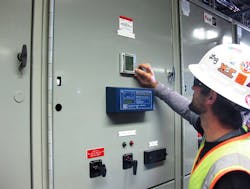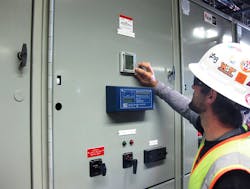Sizing Circuit Protection and Conductors — Part 1
Suppose you have a 60A breaker supplying a branch circuit. What size conductors do you need for that circuit? One table in the NEC says No. 8; another says No. 4. Which one is right? What does the note about ambient temperature correction factors mean? And how do you know you need that size breaker in the first place?
Let’s start with looking at the order of the calculations. The overcurrent protection device (OCPD) — whether a breaker or a fuse — defines the circuit. So sizing the OCPD logically comes before sizing the conductors. But before you can size the OCPD, you have to determine what load it will supply.
Load calculations
Loads may be continuous (operating 3 hr or longer) or noncontinuous. Your first step in branch circuit load calculations is to characterize each load as either continuous or noncontinuous. This distinction is critical. If you mischaracterize just one continuous load as noncontinuous, you could undersize the OCPD and the conductors.
Make sure you avoid the trap of assuming lighting is noncontinuous if controlled by occupancy sensors. There’s no guarantee they won’t run less than 3 hr. Even if the controls shut the lights off after 2 hr, sensor trips can keep extending the runtime. Similar logic applies to other types of loads that are on automatic control.
A good practice when performing branch circuit calculations is to make a table with two columns — one for
continuous and one for noncontinuous. For each load you can determine that will run less than 3 hr at a time, list it in the noncontinuous column. List all other loads in the continuous column.
You also need to determine if the load you’re supplying is a specific-purpose load covered by another Article in the NEC. To do that, look for your load type in Table 210.2. If it’s a motor, it’s always covered by Art. 430. If it’s a hermetic motor (used in air-conditioners, refrigeration units, and chillers), it’s covered by Art. 430 as well as by
Art. 440 [440.3].
At this point, it seems we’re ready to multiply the total of the continuous loads by 125% [210.19(A)] and then add that number to the total of the noncontinuous loads. For branch circuits, it’s usually just that simple — but not always.
Some loads operate in a mutually exclusive fashion. That’s why when you’re sizing feeders, for example, you use the larger of the heating or air-conditioning load when determining the total load.
Rarely does a branch circuit have loads that are mutually exclusive. However, it can happen. For example, consider an industrial shop that has one portable arc welder and 10 welding outlets. Only one outlet will be in use at any given time (the others are then excluded by dint of not having an arc welder), so all of these are on a single branch circuit.
OCPD sizing
Once you’ve correctly calculated the load, you’re ready to size the OCPD. Breakers and fuses come in standard sizes [240.6]. To size the OCPD, follow what’s known as the “next-size-up” rule. Look at the standard sizes that are larger than your load, and pick the one that’s closest. Do not apply this to motor overload protection. For motor OCPDs, refer to Art. 430. But wait. You calculated your load in VA, and the OCPDs are rated in amps. You’ll have to convert VA to amps. In a DC circuit, you’d just divide VA by the nominal voltage to derive amps. For AC loads, you must also divide by the appropriate phase factor.
For 3-phase loads, you divide the VA by the nominal voltage and by the square root of three (approximately 1.732). If your total 3-phase load in a 480V system is 50,000VA, what size breaker do you need?
50,000VA ÷ (480V × 1.732) = 60.2A. The next size up is 70A.
Note that some types of single-phase loads are routinely supplied by a 3-phase panel. Lights, for example, are single-phase loads. Just make sure you wire the lighting system to achieve balance across the phases.
Conductor sizing
Because sizing conductors isn’t a one-size-fits-all process, the NEC has several ampacity tables. Making matters a bit more complicated, the tables have multiple temperature-rating columns. You can avoid confusion here if you understand the logic of the tables (see Table and Column Selection).
After you select the right table and column in that table, you must apply the:
- Temperature correction factors [310.15(B)(2)], and
- Adjustment factors [310.15(B)(3)].
Depending upon your application, you might also need to apply the correction factors in 310.15(B)(4) through 310.15(B)(7).
The temperature correction factors are based on the expected ambient temperature where you’re installing the conductor. Use the peak expected temperature, not an average.
Adjustment factors vary, depending upon the wiring method. At this point, you should already know the type of raceway and conductor you’re using. You should also know if a raceway or cable will carry more than three current-carrying conductors. Those design decisions logically come ahead of sizing the raceway and conductors, though sometimes it’s necessary to change them late in this process.
Once you’ve applied these factors, you have your conductor ampacity number. Now you just need to look it up in the table you selected, using the appropriate temperature rating column. Follow it to the left to see the minimum conductor size.
Note: You might increase the conductor size due to voltage drop or other considerations.
Typical lighting circuit
Let’s apply the process we’ve learned to sizing the OCPD and conductors for a 480V branch circuit consisting of six 400W lights.
Here’s the 7-step process:
Step 1: Characterize the loads. Regardless of any controls, characterize these lights as continuous loads; there’s no guarantee they will be on for less than 3 hr.
Step 2: Calculate total load. Look up the input wattage (manufacturer’s data). For example, assume it’s 452W.
Calculate kVA. Since lights are actually single-phase loads, you can skip this step. You do not divide the watts by 1.732 for this type of load, even if supplied by 480V.
Step 3: Calculate amps. (452W ÷ 480V) × 6 = 5.65A.
Step 4: Size the OCPD. Use the next size up [240.6], which is 15A.
Step 5. Identify the table. You’re running 3 THHN conductors in EMT. After reading the table headings, it’s obvious that Table 310.15(B)(16) is the correct ampacity table.
Step 6. Apply temperature correction factor. The architect gave you 125°F as the highest expected ambient temperature in the ceiling space. From Table 310.15(B)(2)(b), we see this requires us to multiply the allowable ampacity by 0.5. Alternatively, we can multiply our load amps by 2.
Step 7. Size the conductor per the required ampacity. THHN is in the 90° column, but your connectors are rated for 60°C. Using the 60°C column, we find this circuit requires a conductor at least 14 AWG.
The process for calculating a feeder is different from that of calculating a branch circuit. In Part 2, we’ll dive into that and see what to do.
Lamendola is an electrical consultant based in Merriam, Kan. He can be reached at [email protected].
SIDEBAR: Table and Column Selection
Article 310 provides several ampacity tables: Table 310.15(B)(16) through Table 310.15(B)(21). On top of this, Annex B also provides several ampacity tables: Table 310.15(B)(2)(1) through Table 310.15(B)(2)(10).
Those Annex B tables provide more options for looking up your ampacity, but they aren’t required for that purpose. Always start with the Art. 310 tables, and carefully read the headings. If you don’t find an exact match, you might find it in Annex B.
If you don’t find an exact match in either place, then pick the closest match in Art. 310. You will need to modify it per 310.15(B)(1) through 310.15(B)(7). For most applications, the only modifications you’ll need to make will be the adjustment factors detailed in 310.15(B)(3) and the ambient temperature correction factors [310.15(B)(2)].
This ambient temperature correction requirement exists because you need a larger ampacity to allow for the higher temperature. Choose either the 86°F table [Table 310.5(b)(2)(a)] or the 104°F table [Table 310.5(b)(2)(b)] to find your temperature correction factor. Then, you can either multiply the table ampacity by the correction factor or divide your calculated amps by the correction factor prior to looking up the ampacity.
When you look at the ampacity table, you now have a choice of conductor temperature rating columns. Use the column that matches the rating of your lowest rated termination, device, or conductor [110.14(C)]. Terminations are normally rated for 60°C; thus, you normally use the 60°C column, regardless of the conductor’s temperature rating (unless you have special terminations rated for the higher temperature).
You might put a portion of a circuit in a higher temperature environment, and thus have occasion to use the higher temperature column for that portion if not including terminations in that space. Example D3(a) in Annex D provides an excellent illustration of such a situation.
About the Author

Mark Lamendola
Mark is an expert in maintenance management, having racked up an impressive track record during his time working in the field. He also has extensive knowledge of, and practical expertise with, the National Electrical Code (NEC). Through his consulting business, he provides articles and training materials on electrical topics, specializing in making difficult subjects easy to understand and focusing on the practical aspects of electrical work.
Prior to starting his own business, Mark served as the Technical Editor on EC&M for six years, worked three years in nuclear maintenance, six years as a contract project engineer/project manager, three years as a systems engineer, and three years in plant maintenance management.
Mark earned an AAS degree from Rock Valley College, a BSEET from Columbia Pacific University, and an MBA from Lake Erie College. He’s also completed several related certifications over the years and even was formerly licensed as a Master Electrician. He is a Senior Member of the IEEE and past Chairman of the Kansas City Chapters of both the IEEE and the IEEE Computer Society. Mark also served as the program director for, a board member of, and webmaster of, the Midwest Chapter of the 7x24 Exchange. He has also held memberships with the following organizations: NETA, NFPA, International Association of Webmasters, and Institute of Certified Professional Managers.


